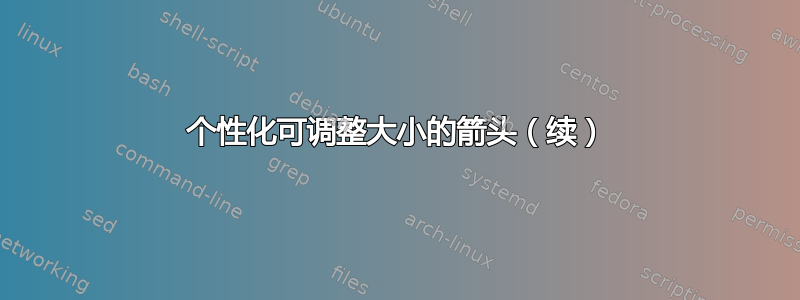
在另一个问题中(个性化大箭头),我曾问过如何制作个性化箭头(针对此代码中的第一种情况),但我无法正确制作第二种情况(如照片所示)。
\documentclass [12pt, a4paper, onecolumn, fleqn] {article}
\usepackage [portuguese] {babel}
\usepackage [utf8] {inputenc}
\usepackage [T1] {fontenc}
\usepackage{siunitx}
\usepackage {amsmath}
% temporary fix
\usepackage{expl3}
\ExplSyntaxOn
\int_zero_new:N \g__prg_map_int
\ExplSyntaxOff
% end of temporary fix
\usepackage{tikz}
\usetikzlibrary{decorations.markings,
decorations.pathreplacing,
calligraphy}
\pagestyle {plain}
\pagenumbering{gobble}
\begin{document}
{\flushleft
13)
\vspace{10px}
\begin{align*}
y(t) = \text{?}
\end{align*}
\vspace{30px}
sabendo que
\begin{align}
& H(p) = \dfrac{(p + 3)}{(p^{2} + 3p + 2)} \\
& y(0^{-}) = 1 \\
& y'(0^{-}) = 2 \\
& f(t) = u(t)
\end{align}
\vspace{30px}
(i) por convolução
\vspace{30px}
Sabe-se, por definição, que
\begin{align}
y(t) = y_{o}(t) + y_{x}(t)
\end{align}
\vspace{30px}
onde
\begin{align*}
y_{o}(t) \rightarrow \text{resposta à entrada zero} \\
y_{x}(t) \rightarrow \text{resposta ao estado zero}
\end{align*}
\vspace{30px}
De (1), deduz-se que
\begin{align}
(D^{2} + 3D + 2)y(t) = (D + 3)f(t)
\end{align}
\vspace{30px}
De (6), deduz-se que
\begin{align}
(\lambda^{2} + 3\lambda + 2) = 0
\end{align}
\vspace{30px}
Logo,
\begin{align}
& (\lambda + 1)(\lambda + 2) = 0 \nonumber \\
& \lambda = -1 \\
& \lambda = -2
\end{align}
\vspace{30px}
De (8) e de (9), deduz-se que
\begin{align}
y_{o}(t) = c_{1}e^{-t} + c_{2}e^{-2t}
\end{align}
\vspace{30px}
Derivando (10), tem-se que
\begin{align}
y_{o}'(t) = -c_{1}e^{-t} - 2c_{2}e^{-2t}
\end{align}
\vspace{30px}
Substituindo (2) em (10), tem-se que
\begin{align}
& c_{1}e^{-(0)} + c_{2}e^{-2(0)} = 1 \nonumber \\
& c_{2} = 1 - c_{1}
\end{align}
\vspace{30px}
Substituindo (3) e (12) em (11), tem-se que
\begin{align}
& -c_{1}e^{-(0)} - 2(1 - c_{1})e^{-2(0)} = 2 \nonumber \\
& -c_{1} - 2 + 2c_{1} = 2 \nonumber \\
& c_{1} = 4
\end{align}
\vspace{30px}
Substituindo (13) em (12), tem-se que
\begin{align}
c_{2} & = 1 - 4 \nonumber \\
& = -3
\end{align}
\vspace{30px}
Substituindo (13) e (14) em (10), tem-se que
\begin{align}
y_{o}(t) = 4e^{-t} - 3e^{-2t}
\end{align}
\vspace{30px}
Sabe-se, pelo Método do Casamento do Impulso, que
\begin{align}
h(t) = [P(D)y_{m}(t)]\;u(t),\quad (M < N)
\end{align}
\vspace{30px}
sendo
\begin{align}
& y_{m}(0) = y'_{m}(0) = y''_{m}(0) = ... = y^{(N - 2)}_{m}(0) = 0 \\
& y^{(N - 1)}_{m}(0) = 1
\end{align}
\vspace{30px}
Como $N = 2$, tem-se que
\begin{align}
& y_{m}(0) = 0 \\
& y'_{m}(0) = 1 \\
& y_{m}(t) = c_{3}e^{-t} + c_{4}e^{-2t}
\end{align}
\vspace{30px}
Derivando (21), tem-se que
\begin{align}
& y'_{m}(t) = -c_{3}e^{-t} + -2c_{4}e^{-2t}
\end{align}
\vspace{30px}
Substituindo (19) em (21), tem-se que
\begin{align}
& c_{3}e^{-(0)} + c_{4}e^{-2(0)} = 0 \nonumber \\
& c_{4} = -c_{3}
\end{align}
\vspace{30px}
Substituindo (20) e (23) em (22), tem-se que
\begin{align}
& -c_{3}e^{-(0)} + -2(-c_{3})e^{-2(0)} = 1 \nonumber \\
& -c_{3} + 2c_{3} = 1 \nonumber \\
& c_{3} = 1
\end{align}
\vspace{30px}
Substituindo (24) em (23), tem-se que
\begin{align}
c_{4} & = -(1) \nonumber \\
& = -1
\end{align}
\vspace{30px}
Substituindo (24) e (25) em (21), tem-se que
\begin{align}
y_{m}(t) = e^{-t} - e^{-2t}
\end{align}
\vspace{30px}
De (6), deduz-se que
\begin{align}
P(D) = D + 3
\end{align}
\vspace{130px}
Substituindo (26) e (27) em (16), tem-se que
\begin{align}
h(t) & = [(D + 3)(e^{-t} - e^{-2t})]\;u(t) \nonumber \\
& = [D(e^{-t} - e^{-2t}) + 3(e^{-t} - e^{-2t})]\;u(t) \nonumber \\
& = (-e^{-t} + 2e^{-2t} + 3e^{-t} - 3e^{-2t})\;u(t) \nonumber \\
& = (2e^{-t} - e^{-2t})\;u(t)
\end{align}
\vspace{30px}
Sabe-se, por definição, que
\begin{align}
y_{x}(t) & = f(t) * h(t) \nonumber \\
& = h(t) * f(t) \nonumber \\
& = \int_{-\infty}^{+\infty}h(\tau)\;f(t - \tau) \; d\tau
\end{align}
\vspace{30px}
Substituindo (4) e (28) em (29), tem-se que
\begin{align}
y_{x}(t) = \int_{-\infty}^{+\infty}(2e^{-\tau} - e^{-2\tau})\;u(\tau)\;u(t - \tau) \; d\tau
\end{align}
\vspace{30px}
De (30), deduz-se que
\begin{align}
& (2e^{-\tau} - e^{-2\tau})\;u(\tau) = 0, \quad (\tau < 0) \\
& u(t - \tau) = 0, \quad (\tau > t)
\end{align}
\vspace{150px}
Separando a análise de (31) e (32) em dois casos, tem-se que
\begin{align*}
\text{1\si{\degree} caso:} \; t < 0
\end{align*}
\vspace{20px}
\begin{tikzpicture}[
LH/.style = {decoration={markings, mark=between
positions 0.01 and 1 step 4mm with
{\draw (-2pt,-2pt) -- (2pt,2pt);}},
postaction={decorate}
},
RH/.style = {decoration={markings, mark=between
positions 0.01 and 1 step 4mm with
{\draw (2pt,-2pt) -- (-2pt,2pt);}},
postaction={decorate}
},
BC/.style = {decorate,
decoration={calligraphic brace, amplitude=6pt,
raise=3mm, #1},% for mirroring of brace
thick, pen colour={blue}
},
]
\draw[LH] (0,0) -- (0.6\linewidth,0);
\draw[RH] (\linewidth,0) node[below=2mm] {$\tau\to$} --
(0.4\linewidth,0);
\draw (0.4\linewidth,2mm) -- ++ (0,-4mm) node[below] {$t$};
\draw (0.6\linewidth,2mm) -- ++ (0,-4mm) node[below] {$0$};
\draw[BC] (0,0) --
node[above=5mm] {$(2\mathrm{e}^{-\tau}- 2\mathrm{e}^{-2\tau})u(\tau)$}
(0.6\linewidth,0);
\draw[BC] (\linewidth,-4mm) --
node[below=5mm] {$u(t-\tau)$}
(0.4\linewidth,-4mm);
\end{tikzpicture}
\begin{align*}
\text{2\si{\degree} caso:} \; t > 0
\end{align*}
\vspace{20px}
\begin{tikzpicture}[
LH/.style = {decoration={markings, mark=between
positions 0.01 and 1 step 4mm with
{\draw (-2pt,-2pt) -- (2pt,2pt);}},
postaction={decorate}
},
RH/.style = {decoration={markings, mark=between
positions 0.01 and 1 step 4mm with
{\draw (2pt,-2pt) -- (-2pt,2pt);}},
postaction={decorate}
},
BC/.style = {decorate,
decoration={calligraphic brace, amplitude=6pt,
raise=3mm, #1},% for mirroring of brace
thick, pen colour={blue}
},
]
\draw[LH] (0,0) -- (0.4\linewidth,0);
\draw[RH] (\linewidth,0) node[below=2mm] {$\tau\to$} -- (0.4\linewidth,0);
\draw (0.4\linewidth,2mm) -- ++ (0,-4mm) node[below] {$0$};
\draw (0.6\linewidth,2mm) -- ++ (0,-4mm) node[below] {$t$};
\draw[BC] (0,0) --
node[above=5mm] {$(2\mathrm{e}^{-\tau}- 2\mathrm{e}^{-2\tau})u(\tau)$}
(0.4\linewidth,0);
\draw[BC] (\linewidth,-4mm) --
node[below=5mm] {$u(t-\tau)$}
(0.6\linewidth,-4mm);
\end{tikzpicture}
}
\end{document}
答案1
请不要误会我的意思,但您的代码并不是真正简单的。您可能会惊讶地发现,为了获得类似于屏幕截图的效果,您可能不需要加载任何库。这里有更简单的代码,可以说相当接近地重现了您的屏幕截图。
\documentclass[tikz,border=3.14mm]{standalone}
\usetikzlibrary{patterns,positioning}
\begin{document}
\begin{tikzpicture}
\draw (-4,0) -- (6,0) node[below] {$\tau$};
\draw[thick] (0,0.25) -- (0,-0.25) node[below] {$0$};
\draw[thick] (2,0.25) -- (2,-0.25) node[below] {$t$};
\fill[pattern=north east lines] (-4,-0.1) rectangle (0,0.1);
\fill[pattern=north west lines] (2,-0.1) rectangle (6,0.1);
\node[anchor=west] (legenda) at (-4,-1) {legenda};
\node[below=3mm of legenda.south west, anchor=west,pattern=north east lines,
minimum width=2cm,minimum height=4mm] (legenda1){};
\node[below=3mm of legenda1.south west, anchor=west,pattern=north west lines,
minimum width=2cm,minimum height=4mm] (legenda2){};
\draw[-latex] (legenda1.east) -- ++ (0.5,0) node[right]{$\left(2\mathrm{e}^{-\tau}
-\mathrm{e}^{-2\tau}\right)\mu(\tau)=0$};
\draw[-latex] (legenda2.east) -- ++ (0.5,0) node[right]{$\mu\left(t-\tau\right)=0$};
\end{tikzpicture}
\end{document}
您将能够将 插入到您的文档中,即以 开头和以 结尾的tikzpicture内容,只要您在序言中添加,即在和之间的某个地方。\begin{tikzpicture}\end{tikzpicture}\usetikzlibrary{patterns,positioning}\usepackage{tikz}\begin{document}




